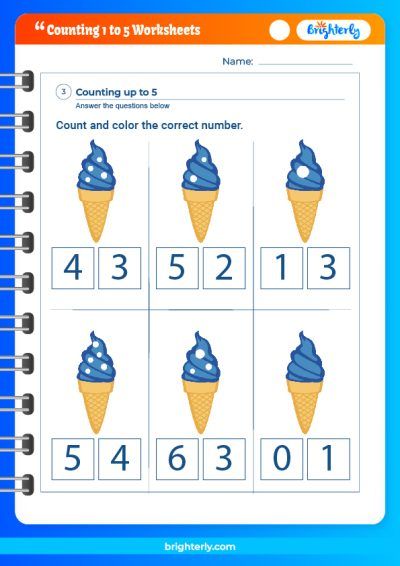Counting Numbers – Definition with Examples
Updated on January 1, 2024
As a significant foundation in every child’s learning journey, counting numbers are the stepping stones to more advanced mathematical concepts. Here at Brighterly, we believe in making learning an engaging and enjoyable process for every child. We’re dedicated to providing high-quality learning resources to help children understand and master the world of counting numbers. In this blog post, we’re going to dive deep into the concept of counting, its importance, and the different stages of learning it, from 1 to 20, then 1 to 100, to counting from 100 to 1000, and even beyond. We’ll also explore number names, counting with hands, practical examples, and questions that will help strengthen your child’s counting abilities. By the end of this post, we hope to give your children the confidence and skills they need to navigate the numerical world around them.
What is Counting?
The first step in a child’s mathematical journey is often counting. Counting involves assigning a unique number to each item in a set. This is done by creating a one-to-one correspondence between the set of items and a set of numbers. This fundamental mathematical skill not only helps children understand the concept of quantity but also forms the basis for more complex operations like addition, subtraction, multiplication, and division.
Counting Numbers from 1 to 20
Starting with counting numbers from 1 to 20 helps children develop a sense of order and sequence. Counting is not simply about memorizing numbers, but about understanding their order and the quantities they represent. For example, if we have a basket of apples, each apple can be assigned a unique number, from one to the total number of apples in the basket.
Counting Numbers from 1 to 100 (One to Hundred)
Once a child is comfortable with counting to 20, the next challenge is counting numbers from 1 to 100. This is a significant milestone as it introduces the concept of ‘tens’ and ‘ones’, and the notion of place value in our decimal system. It also helps children recognize patterns in numbers, which plays a crucial role in developing their problem-solving and logical thinking skills.
Count 100 to 1000
Upon mastering counting to 100, children are ready to tackle counting from 100 to 1000. This introduces them to the concept of ‘hundreds’ and strengthens their understanding of place value. It also prepares them for more advanced arithmetic operations involving larger numbers.
Number Names 1 to 100
Learning the number names from 1 to 100 is an essential aspect of developing numerical literacy. This knowledge helps bridge the gap between numerals and words, facilitating effective communication of mathematical concepts. For example, ’15’ is the numeral, and ‘fifteen’ is the number name.
At Brighterly, we believe that practice is the key to mastery. That’s why we invite you to explore our counting numbers worksheets, where you can find an array of additional practice questions, complete with answers.
Counting in Numbers with Hands
Counting in numbers with hands is an effective and interactive approach to teaching counting. It helps children visualize quantities and understand the abstract concept of numbers. For instance, holding up three fingers physically represents the number ‘three’, making the idea more concrete and relatable.
Counting Numbers Examples
Real-world examples of counting numbers help children apply their counting skills and reinforce their learning. For instance, counting the steps while climbing stairs or counting the number of spoons when setting the table can make learning fun and engaging.
Practice Questions on Counting Numbers
To consolidate the understanding of counting numbers, children can engage in various exercises involving practice questions on counting numbers. These can range from counting objects in a picture to filling in missing numbers in a sequence. Such activities can help reinforce their number sense and boost their confidence in using numbers.
Conclusion
At Brighterly, we understand the pivotal role that counting numbers play in a child’s academic journey and their understanding of the world around them. The journey of counting, from grasping the order of numbers to understanding number names, from counting with hands to applying counting skills in real-life situations, is a fascinating adventure. Through our range of learning resources and tools, we aim to make this journey engaging, exciting, and meaningful for your child. Remember, every big mathematician was once a child learning to count. With patience, practice, and the right guidance, your child will be well on their way to mastering the beautiful language of mathematics.
Frequently Asked Questions on Counting Numbers
Why do we start counting from one?
We start counting from one because one signifies the existence of a single unit or object. When we count, we’re essentially determining the total number of units in a set. Since one represents the first unit or object, it is natural to start counting from one.
What is the sequence of numbers?
The sequence of numbers refers to the arrangement of numbers in a specific order. The most common sequence we use in daily life is the natural number sequence, which starts from one and goes on to two, three, and so on. The sequence helps us understand the order of numbers and the relationships between them, like which number is larger, smaller, or whether two numbers are equal.
How does counting help in real life?
Counting plays a crucial role in our everyday life. It helps us determine quantities, like how many apples are in the basket or how many books are on the shelf. It is essential for telling time, measuring distances, shopping, cooking, and even organizing our daily tasks. Counting is truly the language through which we interpret and interact with the world around us.






